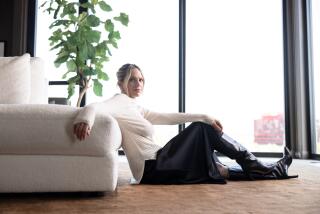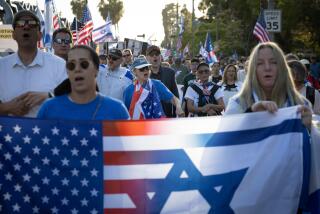Feminist Jewish Theologian Leads the Way Along Lonely Path
- Share via
As part of a three-day retreat for a group of women leaders in Reform Judaism last fall in Albany, N.Y., theologian Judith Plaskow and Rabbi Ruth Sohn led a service addressing God as a female. “It was simply a matter of changing pronouns,” Plaskow said. “We called God she instead of he. “
The immediate response was resentment, despite the fact that Reform has been the most liberal of Judaism’s major branches. “This was disgusting,” one woman told Plaskow.
But over the course of the retreat, as the 200 participants, all leaders in their congregations, discussed their own experiences with religion, as they wrote midrash (textual interpretation and elaboration) on the Genesis story of the relationship between Rachel and her sister Leah, and as Plaskow and Sohn talked about reclaiming the Jewish tradition by re-examining the past, the women began to undergo what Plaskow calls “a gradual process of noticing.”
Idea to Believe In
One participant suggested, as the retreat was ending, “What you have been doing here is trying to find an idea of God we can really believe in.”
This sort of consciousness-raising is taking place today in many circles outside synagogues, said Plaskow, a feminist Jewish theologian who finds herself increasingly invited to speak on college campuses and for women’s groups. “People in the Jewish community are hungry for speakers who can talk about spirituality. Jews really don’t know how to talk about God.”
Plaskow, a New Yorker who now teaches at Roman Catholic-operated Manhattan College in the Bronx, recently spent a week at USC as visiting Firestone Professor in the School of Religion, a professorship that is rotated annually among representatives of major faiths.
“When we decided to invite a Jewish feminist scholar this year, Judith was the obvious choice,” said Sheila Briggs, who teaches in the department of religion at USC and coordinated the Plaskow visit. “She has made such contributions to the whole field of feminist theology.”
Leader Since 1968
Sitting in a cluttered faculty office on the USC campus, Plaskow reflected on the course of the feminist spirituality movement. She has been a leader in the movement since 1968, when she became one of the first women admitted to the graduate study of religion at Yale University and began organizing protests there. “We didn’t read the works of a single woman,” she noted.
She began teaching courses in women and religion in the early 1970s, “which was a struggle because there were so few sources,” and in 1979 co-edited “Womanspirit Rising: A Feminist Reader in Religion,” which remains a definitive overview of the new theological movement. Since the early 1970s, when women’s enrollment in divinity schools began to climb, the number of feminist theologians, women rabbis and ministers has increased steadily. But Plaskow is not overly encouraged.
“To some extent, these movements (academic and ordination) have stayed separate,” she said. “I’m not convinced that ordination of women leads to anything more than just another new role. I don’t see evidence that it leads to changes out of itself.
“Women are often more hesitant to raise feminist issues in their own congregations. They are afraid they’ll be accused of pushing too hard--they are often second-guessing themselves. I don’t see the fact of their presence in itself as being that dramatic.”
‘This Is Too Little’
Changes are occurring in Judaism, she acknowledged. “Women are being ‘called to Torah’ (reading) more, giving more sermons, participating on more committees. But this is too little. Nothing much is happening in theological schools--they are just putting women through the same academic routines the men have always had.”
What changes would she like to see?
“First, they could begin to study women’s history as part of Jewish history--not just whether there were women prophets or rabbis in our tradition, but the social history of women, what their experiences meant. Secondly, they could do more experimentation with liturgy, meaning the creation of new liturgies in seminary synagogues. There are some experiments, but they are isolated and few in number.
“The real avenues for expanding women’s thinking today,” she continued, “are the Rosh Hodesh groups.”
Rosh Hodesh, the “New Moon,” is traditionally a half holiday for women. On this day, customarily, women “don’t do some domestic thing, like the family laundry. Now there are many Rosh Hodesh groups in which the women do something that has significance. Many of them are consciousness-raising. It might begin with women introducing themselves by invoking their mother’s name, their grandmothers’ names. They might meditate on the months in the Jewish calendar, the rhythms of the month, connecting God and nature, trying to find God in their own identity.
All Around the Country
“I travel a lot and I am finding these Rosh Hodesh groups all around the country.”
The scholar, who is currently “trying to write a Jewish feminist theology,” discusses her concern with traditional language, imagery and liturgy, a concern common to all feminist theologians, in a major essay in Susannah Heschel’s 1983 book, “On Being a Jewish Feminist.”
“One consequence of the nature of male God-imagery as a model for community,” Plaskow wrote, “is that the prayer book becomes testimony against the participation of women in Jewish religious life. Women’s greater access to Jewish learning, our increased leadership in synagogue ritual, only bring to the surface deep contradictions between equality for women and the tradition’s fundamental symbols and images for God. While the active presence of women in congregations should bespeak our full membership in the Jewish community, the language of the service conveys a different message. It impugns the humanity of women and ignores our experience, rendering that experience invisible, even in the face of our presence.”
Such radical criticism can be terrifying, Plaskow conceded, particularly since no one is sure what the extent of the change will be.
“The same fear comes up everywhere,” she said, “whether I’m talking to a student or an adult group: Once you start to change, what are the limits? The debate today ranges from the ordination of women to the idea that the tradition will have to be changed inside out.”
Lonely Territory
As a result, even as their numbers grow, feminist theologians find themselves in lonely territory.
“A certain percentage of academic women have been alienated,” Plaskow said. “People don’t necessarily want us around. They prefer to hear an ordained minister who isn’t going to shake the foundations.”
And the non-orthodox nature of their scholarship tends to put feminist scholars in an intellectual “Catch-22” bind, she added. Not only are their demands for change largely rejected by religious institutions, their underlying belief that reform of the sexist traditions in religion is necessary to support full human dignity for women is thoroughly ignored by the feminist secular movement.
“I think it goes back to that old radical line, that religion is intrinsically reactionary,” Plaskow said. “Ms. Magazine has been around for 15 years and only published its first articles on feminist spirituality last year. That’s not excusable.”
Ideas Rejected
The result of this, she said, is that “many important ideas are rejected by religious journals because they are feminist, and by feminist journals because they are religious.”
To fill that gap, Plaskow and Catholic theologian Elisabeth Schussler Fiorenza, “after 10 years of talking about it,” launched the Journal of Feminist Studies in Religion (Scholars Press) last year. The academic journal is aimed at reflecting the scope of feminist scholarship now under way, as well as the ways women are living it. The journal’s debut edition, with articles ranging from studies of Cretan goddesses to dualism and Buddhism, the spiritual liberation of black women, and the psychology of religion, indicated that the scope is indeed broad.
Last year’s first two issues of the new journal have resulted in a circulation of 1,100 and a flood of manuscripts from scholars around the country. “We are absolutely swamped with manuscripts,” said Plaskow, who estimated that she now spends about a third of her time editing the journal. “The reaction has been very good.”
More to Read
Sign up for Essential California
The most important California stories and recommendations in your inbox every morning.
You may occasionally receive promotional content from the Los Angeles Times.










